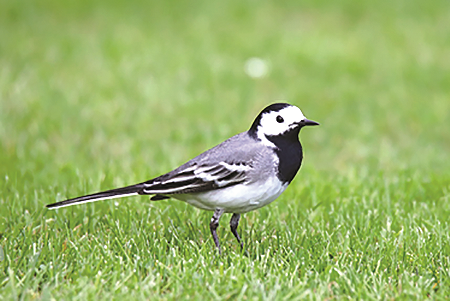My the title, you would assume, we are talking about dogs wagging their tails. But wagging tails is not just a canine phenomenon. Many birds wag their tails too, and some cannot stop it and compulsively keep wagging their tails, so much so that their whole family has earned the name “Wagtails”.
Wagtails are colorful, slender & active birds under the genus “Motacilla”. Most of them are migratory to our region, flying long distances from their breeding grounds across Central Asia, Temperate Europe, East China, or closer home from Himalayan highlands. Every winter season, you can spot these hyperactive birds which mostly feed on the ground. In our parks, when maalis water the grass, it’s not uncommon to sight a few of them, fly down to grassy patches and pick some easy grub. Amongst the common ones we see are the White Wagtail and Yellow Wagtails, both of which show a lot of variation in their coloration. The next common one is Citrine Wagtail but that is more commonly seen around open countryside, so if you head towards Sohna, Palwal, or Basai, in the open fields, these can be easily spotted. Citrine is characterized by a clear yellow face with yellow curving behind its ears. While Yellow Wagtail has all shades of yellow but doesn’t have the yellow face of the Citrine. Only one Wagtail is resident and that’s White-browed Wagtail. True to its name, it has a neat white eyebrow on an otherwise blackish/deep grayish body. A more uncommon species is the Grey Wagtail, which found solitary near flowing streams and drains. It also looks very close to Yellow Wagtail but has a longer tail and a deep yellow vent an identification feature. They spend the winter months in South India.
In Valparai, a group of children watch these Grey Wagtails every year. These children a create list of wagtails seen and heard and upload them on ebird, a citizen science initiative. Wagtails are called Khanjan in Hindi. Ramcharitmanas, penned by Tulsidas, mentions Khanjan multiple times. Khanjan is used to refer to anyone who cannot stay still or is always fidgeting, but in the way of beauty and brilliance. The forest of Sundarvan in Bhagalpur is described as full of Khanjan birds, while Sita’s brilliantly darting eyes are likened to Khanjan when she playfully darts a glance at Ram, for a group of ladies who are quizzing her on her partner.
Wagtails are fascinating to watch. For their beautiful plumages and hyper energy. Look out for these beautiful guests around you and share your sightings on ebird.org.
Popular Stories
How To Revive Your Rainwater Harvesting System
The Water Couple’s Journey: From Cleaning Tanks to Complete Water Solutions!
Locals Felling Trees Near Sec A Pkt C
Winning Has Become a Habit for Divya
Is Green Park Heading Towards A Slum
Haphazard Parking, Narrow Walking Space In M Block Market
Recent Stories from Nearby
- Elections at Silver Oaks April 5, 2025
- Silver Oaks Rangotsav: A Vibrant Celebration of Holi April 5, 2025
- Sarvam Shakti: A Decade of Empowerment and Grace April 5, 2025
- Turning Waste into a Valuable Resource April 5, 2025
- Stray Dogs Menace & Management, A Block Extension April 5, 2025







